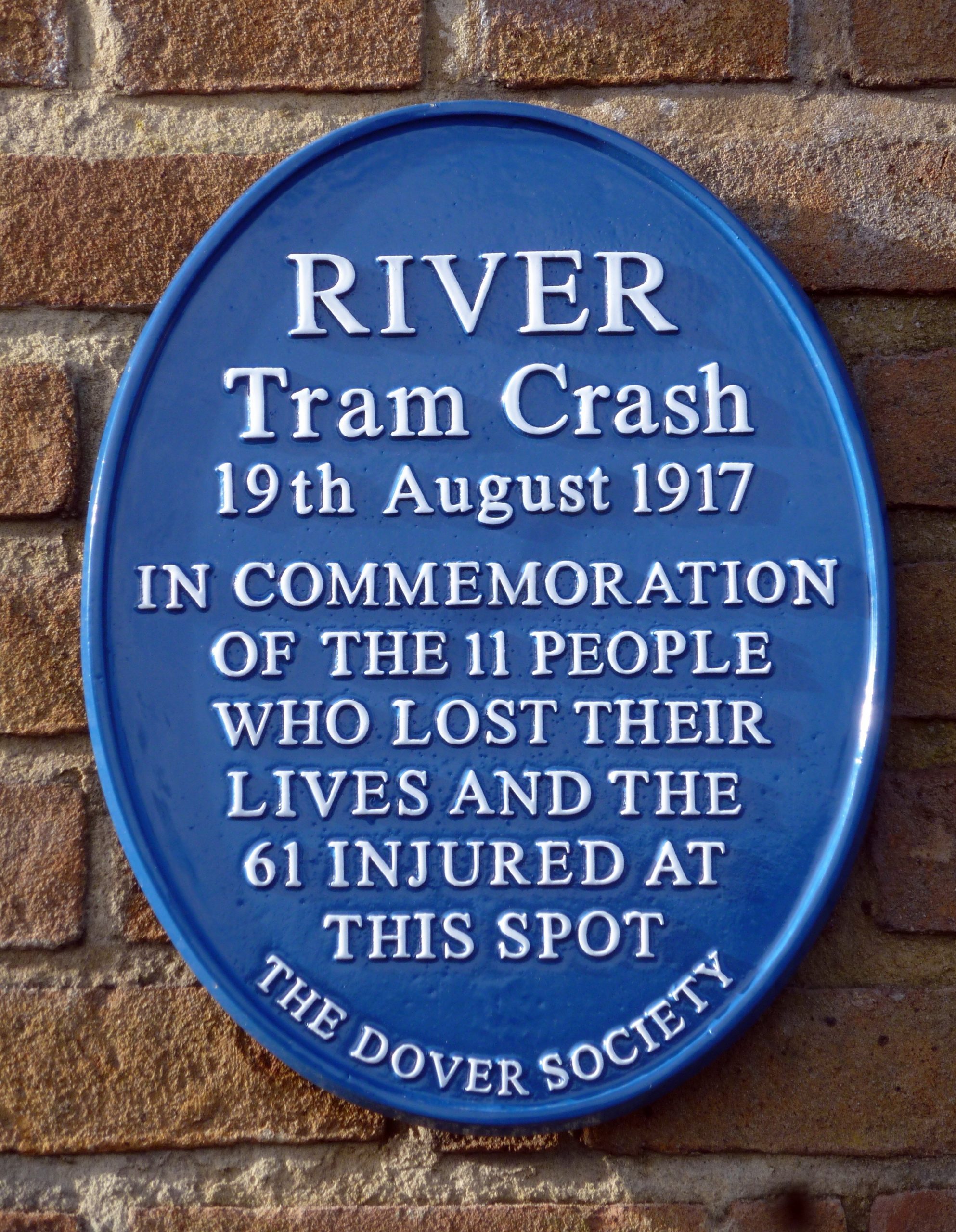This plaque was unveiled on 29th January 2015
The plaque is situated on the wall of the northern parapet of the of the River Dour bridge at the bottom of the second bend of the incline on Crabble Road and the upper deck smashed into the wall.
This article appeared in edition 82 of the Dover Society Newsletter on pages 20 and 21.
River Tram Plaque 29th January 2015
Derek Leach
The following is the speech given by our Chairman Derek Leach on the unveiling of the Dover Society plaque commemorating the River tram crash 1917.
Good morning and welcome everybody, especially the Chairman of River Parish Council, Clive Taylor, some fellow parish councillors, residents of Crabble Mill and Mill Race, Malcolm Mitchell of Smith Woolley Perry, who manage the site on behalf of Crabble Mill Developments and John Hill who kindly erects our plaques free of charge.
To mark the Millennium in 2000 The Dover Society erected 10 plaques in Dover to commemorate certain events and people. Since then we have added several more, but this is our first plaque outside the town.
Dover Corporation owned the town’s tram system, which was only the second in the country when the mayor drove the first tram in 1897. In 1905 the system was extended to River, along what is now Lewisham Road to its terminus. In those days and until the end of 1936, when buses replaced the trams, the people of Dover packed the trams to get to work, to go shopping and to ride into the River countryside.
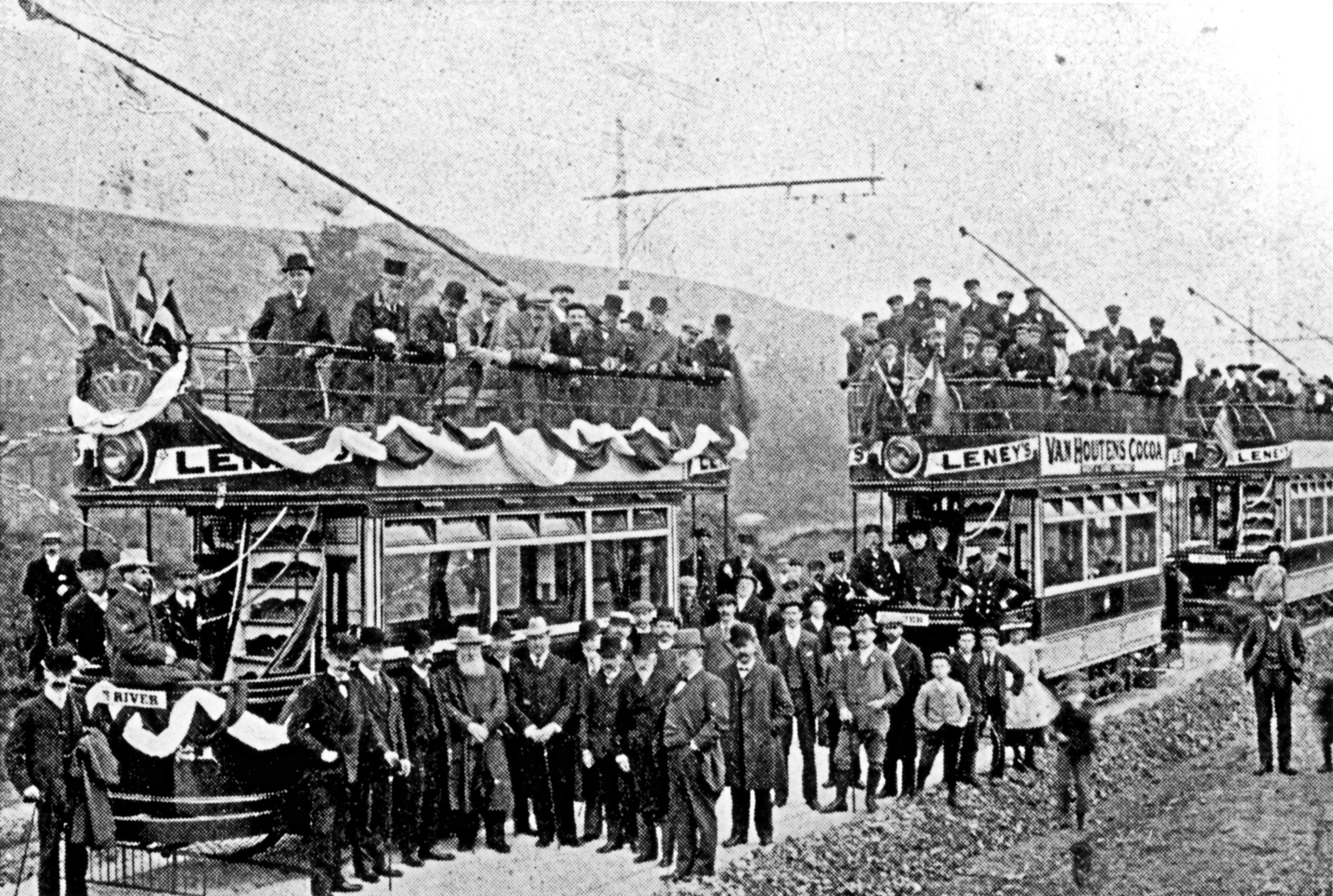
The opening of the tramline extension to River on 2nd October 1905 curtesy of Dover Museum
But in 1917 tragedy struck when, on 19 August 1917, a heavily loaded tram on its way to the River terminus careered down the hill into River, crashing into the wall of the Crabble Rag Mill and overturning. Eleven people were killed and 61 injured, one of whom later died. Our new plaque marks that tragic spot commemorating the worst tram accident in Britain.
Women had taken on many male jobs during the war, including Lottie Scrase, aged 27, the conductress of the tram. Unfortunately, for her she had volunteered to take another woman’s shift and died as a result. She was engaged to be married so her wedding ring was buried with her.
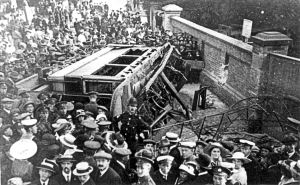
Scene of the River tram crash 19th August 1917
Several servicemen were amongst the dead and injured. Albert Hallam, a teenage soldier stationed in Dover, was a passenger. He was thrown from the top deck and landed on a sailor who was killed, but who cushioned Albert’s fall and saved his life, although he was injured.
A hero that day was Trooper Gunner. As the tram gathered speed he dashed forward and jammed both feet on one of the sets of brakes. It did not stop the tram and both feet had to be amputated. He spent the rest of his life in a wheelchair, no army pension was paid as he was not on duty, but he received the Albert Medal for bravery and a modest pension from a hero’s fund.
My dear friend Lillian Kay was another passenger that day. She, aged 3, and her mother and father were travelling to see her grandfather, the Riverdale House gardener, as they did every week. However, when it reached Buckland Bridge, Mother insisted on getting off and walking the rest of the way. Apparently the previous Saturday it had been top heavy and wobbling as it went down the hill into River. She did not want to risk it again. Walking along Crabble Avenue they heard the crash. Father and a policeman were first on the scene. Mother knocked on a door in Crabble Road, handed over Lillian to whoever opened the door and ran to help. What a lucky escape for Lillian who lived until she was almost 99!
Much of the blame fell on the tram driver, Albert Bissenden, who tried but failed to stop the tram and jumped clear before it crashed. He had been discharged from the wartime army because he had suffered a nervous breakdown and had only passed his tram driving test 19 days previously.
At the inquest, many possible causes were explored, for instance, that the tram capacity was 48 but there were over 70 people on board – not uncommon apparently – but the decision of the coroner was ‘death by misadventure’ due to the inexperience and lack of judgement of the driver.
£13,000 was paid out by the Corporation in compensation and the council rates had to be increased by 1/6 in the £ (7.5p) to pay for it.
So the brief wording of this plaque conceals what was a tragedy for many individuals and their families. Let us spend a moment in silence to remember this incident and its consequences.
Crabble Tram Accident – 19th August 1917
The following article appeared in edition 90 of The Dover Society Newsletter on page 24
Dover’s Tram Tragedy Remembered
Peter Sherred
On Saturday 19 August 2017 at Crabble Corn Mill River in the presence of the Chairman of Dover District Council, Councillor Sue Chandler, the Dover Society organised a centenary memorial presentation honouring the people who died and those who were injured, some quite seriously, in the Crabble tram accident of 1917. The accident took place during the Great War of 1914-1918 on Sunday 19th August 1917 at Crabble Road River and occurred when an out of control tram hit the northern parapet of the River Dour Bridge. The tram had overturned at the bottom of the second bend on Crabble Road and the upper deck smashed into the wall. Eleven people were killed (including the tram’s experienced conductress Lottie Scrase) and 51 civilians plus 9 military personnel were injured. The site of the crash is marked by a blue Dover Society plaque. The Crabble tram accident of 1917 remains one of the worst on record. The subsequent coroner’s verdict recorded ‘the deaths were caused by the tram-car running away and overturning, and that the accident was caused through by the error of judgement and inexperience of the driver of the car, and that the deceased’s met their deaths through misadventure’.
The centenary presentation was given by members of the Dover Tales led by Barry O’Brien, supported by Ray Newsam, Caroline Fox-Betts and Stephanie and Chris Precious whose oral presentation of the tragedy was accompanied by Paul Cheneour on the flute. The script was drawn from and inspired by various reports and correspondence published at the time of the crash. Additionally, the Dover Tales members gave three other pieces including one about the Christmas Eve 1914 bomb dropped on Leyburne Road, another inspired by childhood memories of a River resident and a further one was an adaptation of a Dalmatian Fairy Tale in acknowledgement of Dover’s twinning with Split in Croatia.
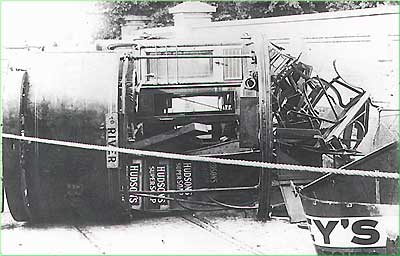
Tram No. 20 (built in 1915) overturned at Crabble Road 1917
Because of the nature of the route into River, combining significant bends and a steep gradient, tram drivers on this route pre-war were all experienced drivers for whom it was usual at the top of Crabble Road to stop the tram and turn the control key to the off position in order to cut the power supply. This automatically slowed trams down and because the main brakes were rheostatic, electrical braking using a load resistance, they could only be applied if the power was cut off. For whatever reason that Sunday, on that run, the driver did not stop and turn off the control key. This meant that the tram was on full power from the top of the incline. The driver of the No 20 tram on the afternoon of Sunday 19 August 1917 was a local man, Albert James Bissenden, who had volunteered at the outbreak of World War I and became a private in the Army ordnance corps, subsequently being sent to Egypt where he suffered a nervous breakdown and was discharged in February 1917. Following his return to England he made a good recovery and just five weeks before the accident he started work as a tram driver having never driven a tram before. It became clear that he had made a mistake by not switching the engine off at the appropriate place and time and, due to his lack of experience, was unable to rectify the situation.
Nine members of the Bissenden family came from all over England for the centenary presentation including Albert Bissenden’s grandsons David and Alan. Following the presentations the family members, accompanied by the Chairman of the Dover Society – Derek Leach and Lorraine Sencicle – the Dover Historian gathered at the place where the accident occurred. There, beneath the Dover Society plaque, after a short but moving speech given by David the two brothers laid a bouquet in memory of those killed and injured that day 100 years ago.
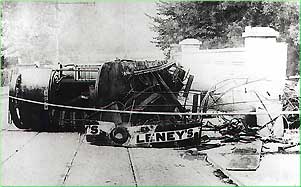
Fatal accident of Tram 20 Crabble Road 1917
Although seating on tram 20 was for 48 passengers on the day of the accident it was evident that the tram was seriously overloaded, the number of passengers given as being 70, a factor which exacerbated the number of casualties.
A detailed and complete article on the tram accident can be read on The Dover Historian. Privately owned and run by Lorraine Sencicle with her husband Alan this web site contains a large collection of historical articles from the town of Dover, England. All are well researched, well written and interesting articles. There are also articles on the many Dovers throughout the world.
I highly recommend a visit to The Dover Historian, to do so go to Crabble Tram Accident – 19 August 1917 | The Dover Historian Editor

